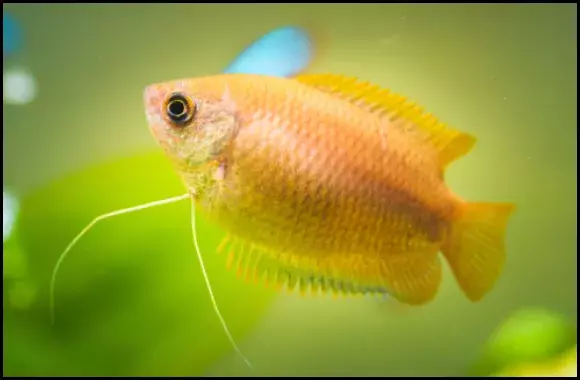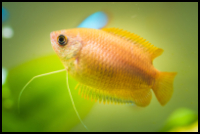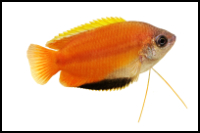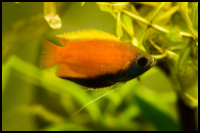





Quick Care Details (Table)
| Livestock Characteristics | Value |
|---|---|
| Care Level | Moderate |
| Temperament | Peaceful |
| Diet | Omnivore |
| Maximum Size | 2.5 Inches |
| Minimum Tank Size | 10 Gallons |
| Plant Safe | Yes |
| Temperature Range | 72-82F |
| PH Range | 6.0-7.5 |
| KH Range | 4-10 |
Species Specific Categories
Helpful Video
Care Details
Aquascape: Create a well-planted aquarium with plenty of floating and submerged vegetation. Honey Gouramis appreciate densely planted areas, which provide hiding spots and mimic their natural habitat.
Substrate: A fine-grained substrate like sand or small gravel is preferred, as it allows them to sift through for leftover food and forage for small invertebrates.
Disease Prevention: Preventive measures, such as maintaining stable water conditions and providing a balanced diet, are key to keeping Honey Gouramis healthy. Ensure that tank mates are compatible and not aggressive.
Filtration: A gentle to moderate filtration system is suitable since these fish prefer calm waters. A sponge filter or a hang-on-back filter with adjustable flow is a good choice.
Lighting: Moderate lighting is sufficient, as Honey Gouramis do not have specific lighting requirements. However, it should support the growth of live plants in the tank.
Water Flow: Honey Gouramis prefer slow to moderate water flow. Consider using decorations or plants to break up strong currents in the tank.
Hardiness: Honey Gouramis are generally hardy and a good choice for beginner aquarists. They can adapt to a range of water conditions but thrive in stable and slightly acidic water.
Acclimation: When introducing new fish, acclimate them gradually to prevent stress and temperature shock. Float the bag and slowly mix tank water with the water in the bag.
Expected Lifespan: With proper care, Honey Gouramis can live for an average of 4 to 5 years. Quality care, a well-maintained tank, and a balanced diet contribute to their longevity.
Special Requirements: Honey Gouramis appreciate peaceful tank mates and a peaceful environment. They do well in a species-only tank or a community tank with non-aggressive fish. Avoid fin-nipping species. Additionally, providing hiding spots and plants is essential for their well-being.
Temperament and Behavior
Behavior: Honey Gouramis are known for their peaceful and gentle nature. They are typically shy and tend to spend most of their time in the middle to upper levels of the aquarium. These fish are not aggressive and make for great community tank residents.
Breeding: Breeding Honey Gouramis is a fascinating endeavor. Males are known for their vibrant colors and build bubble nests at the water's surface. During courtship, males will entice females under the nest to lay eggs. The male then guards the nest and newly hatched fry diligently.
Aggression: Honey Gouramis are among the least aggressive fish in the Gourami family. They usually keep to themselves and are unlikely to display aggression towards other fish, making them a good choice for community aquariums.
Tankmates Compatibility: They are highly compatible with a variety of peaceful community fish. Good tankmates include small tetras, rasboras, peaceful golden barbs, and other non-aggressive Gourami species. Avoid aggressive or fin-nipping species.
Activity Level: Honey Gouramis are generally calm and not overly active swimmers. They prefer leisurely movements through the aquarium, often hovering near plants or the water's surface.
Schooling or Shoaling Behavior: Honey Gouramis do not exhibit schooling or shoaling behavior. They are more solitary and prefer their own space.
Plant Compatibility: They are plant-friendly and will not typically damage aquatic plants. In fact, densely planted tanks with floating vegetation are ideal for providing them with hiding spots and security.
Diet and Nutrition
Dry Foods: Honey Gouramis readily accept high-quality dry foods such as micro pellets, flakes, and granules. These foods provide a well-balanced diet and are convenient for daily feeding.
Frozen Foods: They enjoy frozen foods like daphnia, brine shrimp, and bloodworms. These provide essential nutrients and are a great addition to their diet.
Live Foods: Live foods, such as mosquito larvae, daphnia, and small worms, are highly appreciated by Honey Gouramis. They mimic their natural diet and can be given as occasional treats.
Vegetables: While not a primary part of their diet, you can occasionally offer blanched vegetables like spinach or zucchini. These provide fiber and some variety to their diet.
Algae: Honey Gouramis are not known to consume algae as a significant part of their diet. They are primarily carnivorous.
Feeding Schedule: Feed your Honey Gouramis 2-3 times a day with small portions. Be mindful not to overfeed, as they have small stomachs.
Supplemental Foods: To enhance their color and overall health, consider using color-enhancing or spirulina-based foods as supplements. These can intensify their vibrant hues and keep them in prime condition.
Tank Parameters
Tank Size: For a pair or a small group of Honey Gouramis, a tank size of 20-30 gallons (75-114 liters) is suitable. However, larger tanks of 40 gallons (151 liters) or more provide better space for a small community of these fish.
Tank Length and Measurements: Choose a tank that is at least 24 inches (61 cm) in length to accommodate the swimming and territorial habits of Honey Gouramis. A longer tank provides more swimming space.
Water Temperature: Maintain the water temperature between 77-82°F (25-28°C) to replicate their native tropical environment. Stable temperatures are essential for their well-being.
pH (Acidity/Alkalinity): Keep the pH level in the slightly acidic to neutral range, around 6.0-7.5. Honey Gouramis can adapt to a range of pH levels, but stability is crucial.
KH (Carbonate Hardness): A KH level of 3-8 degrees is suitable for maintaining stable pH. This helps buffer the water and prevent pH fluctuations.
GH (General Hardness): Maintain a GH level of 5-13 degrees. A moderate to slightly hard water condition is generally well-tolerated by these fish.
Hardiness: Honey Gouramis are considered hardy fish when provided with stable water conditions and appropriate care. They can adapt to a variety of water parameters but thrive in conditions that match their preferences.
Nitrate (NO3) levels: Keep nitrate levels below 20 ppm (parts per million) through regular water changes and efficient filtration. Monitoring water quality is vital for their health.
History, Popularity, History and Species Variety Details
Table of Contents
The History, Popularity and Natural Habitat
History: The Honey Gourami (Trichogaster chuna) is a beloved member of the Gourami family, originating from the slow-moving waters of South Asia. They have been cherished by aquarists for decades due to their captivating colors and peaceful temperament. Honey Gouramis were first described by scientists in the 19th century and have since become a staple in the world of freshwater aquariums.
Popularity: Honey Gouramis are incredibly popular in the aquarium hobby, and it's easy to understand why. Their striking appearance, with shades of honey, gold, and red, is a sight to behold. What truly endears them to aquarists, however, is their peaceful disposition and relatively easy care requirements. These attributes make them an ideal choice for both beginners and experienced hobbyists alike.
Natural Habitat: In their native habitat, Honey Gouramis are found in slow-moving or stagnant waters of South Asia, particularly in India and Bangladesh. They thrive in ponds, lakes, and shallow streams densely populated with aquatic plants. Their natural surroundings are often characterized by subdued lighting, which explains their preference for low to moderate lighting in aquariums. These waters are typically warm and slightly acidic, which is why replicating similar conditions in the tank is crucial for their well-being.
Understanding the history, popularity, and natural habitat of the Honey Gourami provides insight into why they have become such a cherished and iconic species in the world of freshwater aquariums.
Back to topVariations of the Dwarf Gourami
- Red Stripped Dwarf Gourami (Trichogaster lalius): This is one of the most well-known and widely kept dwarf Gourami species. They come in various color variations, with the most popular being the Flame Dwarf Gourami, which has vibrant red and blue colors.
- Powder Blue Dwarf Gourami (Trichogaster lalius "Powder Blue"): These Gouramis are known for their powder blue coloration, which is striking and unique. They share the same care requirements as other dwarf Gouramis.
- Sparkling Gourami (Trichopsis pumila): While not a true dwarf Gourami, the Sparkling Gourami is a small, peaceful species. They have a subtle, iridescent appearance and are known for their tranquil behavior.
- Flameback Gourami (Trichogaster chuna): Sometimes confused with the Honey Gourami due to similar appearances, the Flameback Gourami is a separate species. They also have lovely colors and a peaceful disposition.
- Banded Gourami (Trichogaster fasciata): Banded Gouramis are larger than true dwarf Gouramis but are peaceful and share similar care requirements. They feature horizontal stripes and are known for their interesting behavior.
Back to top
Frequently Asked Questions
Do they tolerate heavily planted tanks?
Yes, they appreciate dense plant cover, which provides hiding spots and mimics their natural habitat.
What is their typical lifespan?
With proper care, Honey Gouramis can live for about 4-5 years.
Are there color variations of Honey Gouramis?
Yes, you can find variations like Red Honey Gouramis and Sunset Honey Gouramis with different coloration.
Can I breed Honey Gouramis at home?
Yes, breeding is possible. Males build bubble nests at the water's surface, and they are relatively easy to breed in a well-prepared aquarium.
Do Honey Gouramis need special lighting or filtration?
They do well with moderate lighting and gentle filtration. Avoid strong currents in the tank.
What should I feed my Honey Gouramis?
Honey Gouramis thrive in slightly acidic to neutral water with a pH range of 6.0-7.5, and a temperature of 77-82°F (25-28°C).
Can I keep Honey Gouramis in a community tank?
Absolutely, they are peaceful and can coexist with other non-aggressive fish species like small tetras and rasboras.
How big do Honey Gouramis grow?
Typically, Honey Gouramis reach a size of 2 to 3 inches (5-7.5 cm).
Are Honey Gouramis suitable for beginners?
Yes, Honey Gouramis are excellent choices for beginners due to their peaceful nature and relatively easy care requirements.

